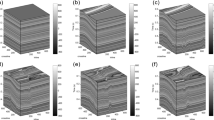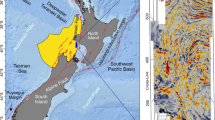Abstract
Limited by the survey data and current interpretation methods, the modelling processes of fault networks are fraught with uncertainties. In hydraulic geological engineering, the location uncertainty of faults plays a vital role in decision-making and engineering safety. However, traditional uncertainty modelling methods have difficulty obtaining accurate uncertainty quantification and topology representation. To this end, we proposed a novel solution for uncertainty analysis and three-dimensional modelling for faults via a deep learning approach. A spatial uncertainty perception (SUP) method is first presented based on a modified deep mixture density network (MDN), which can be used to learn the spatial distributions of fault zones, calculate the probability of fault models, and simulate stochastic models with certain confidence degrees. After that, a graph representation (GRep) method is developed to express the topological form and geological ages of fault networks. The GRep makes it possible to automatically simulate the spatial distributions of fault belts, thus providing an effective way for the uncertainty modelling and assessment of fault networks. The two methods are then performed in the geological engineering of a practical hydraulic project. The results show that this solution can conduct accurate uncertainty evaluations and visualizations on fault networks, thus providing suggestions for subsequent geological investigations.























Similar content being viewed by others
References
Alkan RM, Erol S, İlçi V, Ozulu İM (2020) Comparative analysis of real-time kinematic and PPP techniques in dynamic environment. Measurement 163:107995
Arnold D, Demyanov V, Rojas T, Christie M (2019) Uncertainty quantification in reservoir prediction: part 1 - model realism in history matching using geological prior definitions. Math Geosci 51:209–240
Aydin O, Caers JK (2017) Quantifying structural uncertainty on fault networks using a marked point process within a Bayesian framework. Tectonophysics 712–713:101–124
Bai T, Tahmasebi P (2020) Hybrid geological modeling: combining machine learning and multiple-point statistics. Comput Geosci 142:104519
Bishop CM (2006) Pattern recognition and machine learning. Information science and statistics. Springer, New York
Chan S, Elsheikh AH (2017) Parametrization and generation of geological models with generative adversarial networks. arXiv preprint. https://arxiv.org/abs/1708.01810
Cherpeau N, Caumon G (2015) Stochastic structural modelling in sparse data situations. Pet Geosci 21:233–247
Cherpeau N, Caumon G, Lévy B (2010) Stochastic simulations of fault networks in 3D structural modeling. Comptes Rendus Geosci 342:687–694
Cracknell MJ, Reading AM (2014) Geological mapping using remote sensing data: a comparison of five machine learning algorithms, their response to variations in the spatial distribution of training data and the use of explicit spatial information. Comput Geosci 63:22–33
De La Varga M, Wellmann JF (2016) Structural geologic modeling as an inference problem: a Bayesian perspective. Interpretation 4:SM1–SM16
Feng J, Teng Q, He X, Wu X (2018) Accelerating multipoint statistics reconstruction method for porous media via deep learning. Acta Mater 159:296–308
Georgsen F, Røe P, Syversveen AR, Lia O (2012) Fault displacement modelling using 3D vector fields. Comput Geosci 16:247–259
Goodchild M, Chih-Chang L, Leung Y (1994) Visualizing fuzzy maps. In: Unwin DJ, Hearnshaw HM (eds) Visualization in Geographical Information Systems. John Wiley & Sons, New York
Guo J, Li Y, Jessell MW, Giraud J, Li C, Wu L, Li F, Liu S (2021) 3D geological structure inversion from Noddy-generated magnetic data using deep learning methods. Comput Geosci 149:104701
Han S, Li M, Wang G (2020) Copula-based simulating and analyzing methods of rock mass fractures. Comput Geotech 127:103779
Hettema M (2020) Analysis of mechanics of fault reactivation in depleting reservoirs. Int J Rock Mech Min Sci 129:104290
Hillier MJ, Schetselaar EM, de Kemp EA, Perron G (2014) Three-dimensional modelling of geological surfaces using generalized interpolation with radial basis functions. Math Geosci 46:931–953
Hoffman KS, Neave JW (2007) The fused fault block approach to fault network modelling. Geol Soc Lond Spec Publ 292:75–87
Jia R, Lv Y, Wang G, Carranza E, Chen Y, Wei C, Zhang Z (2021) A stacking methodology of machine learning for 3D geological modeling with geological-geophysical datasets, Laochang Sn camp, Gejiu (China). Comput Geosci 151:104754
Juang CH, Zhang J, Shen M, Hu J (2019) Probabilistic methods for unified treatment of geotechnical and geological uncertainties in a geotechnical analysis. Eng Geol 249:148–161
Kang B, Lee K (2020) Managing uncertainty in geological scenarios using machine learning-based classification model on production data. Geofluids 2020:1–16
Kring K, Chatterjee S (2020) Uncertainty quantification of structural and geotechnical parameter by geostatistical simulations applied to a stability analysis case study with limited exploration data. Int J Rock Mech Min Sci 125:104157
Kwon S, Park G, Jang Y, Cho J, Chu M, Min B (2021) Determination of oil well placement using convolutional neural network coupled with robust optimization under geological uncertainty. J Pet Sci Eng 201:108118
Lecour M, Cognot R, Duvinage I, Thore P, Dulac JC (2001) Modelling of stochastic faults and fault networks in a structural uncertainty study. Pet Geosci 7:S31–S42
Li M, Han S, Zhou S, Zhang Y (2018) An improved computing method for 3d mechanical connectivity rates based on a polyhedral simulation model of discrete fracture network in rock masses. Rock Mech Rock Eng 51:1789–1800
Li M, Zhang Y, Zhou S, Yan F (2017) Refined modeling and identification of complex rock blocks and block-groups based on an enhanced DFN model. Tunn Undergr Space Technol 62:23–34
Li S, Xiong L, Tang G, Strobl J (2020) Deep learning-based approach for landform classification from integrated data sources of digital elevation model and imagery. Geomorphology 354:107045
Liang D, Hua W, Liu X, Zhao Y, Liu Z (2021) Uncertainty assessment of a 3D geological model by integrating data errors, spatial variations and cognition bias. Earth Sci Inform 14:161–178
Liu GF, Jiang Q, Feng GL, Chen DF, Chen BR, Zhao ZN (2021) Microseismicity-based method for the dynamic estimation of the potential rockburst scale during tunnel excavation. Bull Eng Geol Environ 80:3605–3628
Liu XX, Xu YS, Cheng WC, Shen SL, Horpibulsuk S (2017) Investigation of hydraulic parameters of a weathered mylonite fault from field pumping tests: a case study. Bull Eng Geol Environ 76:1431–1448
Ma Z, Mei G (2021) Deep learning for geological hazards analysis: data, models, applications, and opportunities. Earth-Sci Rev 223:103858
McHugh ML (2013) The Chi-square test of independence. Biochem Medica 23:143–149
Mery N, Marcotte D (2021) Quantifying mineral resources and their uncertainty using two existing machine learning methods. Math Geosci 54:363–387
Ministry of Water Resources of the People’s Republic of China (2004) Geological surveying and mapping of hydraulic and hydroelectric engineering. China WaterPower Press, Beijing
Morales M, Panthi KK, Botsialas K, Holmøy KH (2019) Development of a 3D structural model of a mine by consolidating different data sources. Bull Eng Geol Environ 78:35–53
Nguyen BQV, Kim YT (2021) Landslide spatial probability prediction: a comparative assessment of naïve Bayes, ensemble learning, and deep learning approaches. Bull Eng Geol Environ 80:4291–4321
Peacock DCP, Nixon CW, Rotevatn A, Sanderson DJ, Zuluaga LF (2016) Glossary of fault and other fracture networks. J Struct Geol 92:12–29
Renard P, Courrioux G (1994) Three-dimensional geometric modeling of a faulted domain: the Soultz Horst example (Alsace, France). Comput Geosci 20:1379–1390
Schaaf A, Bond CE (2019) Quantification of uncertainty in 3-D seismic interpretation: implications for deterministic and stochastic geomodeling and machine learning. Solid Earth 10:1049–1061
Smirnoff A, Boisvert E, Paradis SJ (2008) Support vector machine for 3D modelling from sparse geological information of various origins. Comput Geosci 34:127–143
Suzuki S, Caumon G, Caers J (2008) Dynamic data integration for structural modeling: model screening approach using a distance-based model parameterization. Comput Geosci 12:105–119
Ursegov S, Zakharian A (2020) Novel approach to geological modeling with combination of machine learning. In: EGU General Assembly Conference Abstracts, Online pp EGU2020–21739
Vollgger SA, Cruden AR, Ailleres L, Cowan EJ (2015) Regional dome evolution and its control on ore-grade distribution: insights from 3D implicit modelling of the Navachab gold deposit, Namibia. Ore Geol Rev 69:268–284
Wang L, Zheng Z, Zhu H (2021) Construction and application of 3D model of engineering geology. In: Abawajy J, Xu Z, Atiquzzaman M, Zhang X (eds) International Conference on Applications and Techniques in Cyber Security and Intelligence. Springer, Cham, pp 512–518
Wei Y, Xing Z, Jian C, Wang K, Wu S, Chiam K (2021) Use of tree-based machine learning methods for stratigraphic classification in 3D geological modelling. IOP Conf Ser Earth Environ Sci 861:072039
Wellmann F, De La Varga M, Güdük N, Von Harten J, Stamm F, Liang Z, Moulaeifard SM (2021) Probabilistic machine learning for improved decision-making with 3-D geological models. In: EGU General Assembly Conference Abstracts, Online pp EGU21–14771
Wellmann JF, De La Varga M, Murdie RE, Gessner K, Jessell M (2018) Uncertainty estimation for a geological model of the Sandstone greenstone belt, Western Australia – insights from integrated geological and geophysical inversion in a Bayesian inference framework. Geol Soc Lond Spec Publ 453:41–56
Wellmann JF, Horowitz FG, Schill E, Regenauer-Lieb K (2010) Towards incorporating uncertainty of structural data in 3D geological inversion. Tectonophysics 490:141–151
Wellmann JF, Lindsay M, Poh J, Jessell M (2014) Validating 3-D structural models with geological knowledge for improved uncertainty evaluations. Energy Procedia 59:374–381
Wellmann JF, Regenauer-Lieb K (2012) Uncertainties have a meaning: Information entropy as a quality measure for 3-D geological models. Tectonophysics 526–529:207–216
Zeraatpisheh M, Ayoubi S, Jafari A, Tajik S, Finke P (2019) Digital mapping of soil properties using multiple machine learning in a semi-arid region, central Iran. Geoderma 338:445–452
Zhang Y, Wang G, Li M, Han S (2018a) Automated classification analysis of geological structures based on images data and deep learning model. Appl Sci 8:2493
Zhang Y, Zhong D, Wu B, Guan T, Yue P, Wu H (2018b) 3D parametric modeling of complex geological structures for geotechnical engineering of dam foundation based on T-splines. Comput Aided Civ Infrastruct Eng 33:545–570
Zhao H, Li S (2021) Determining geomechanical parameters and a deformation uncertainty analysis of the Longtan Hydropower Station slope, China. Bull Eng Geol Environ 80:6429–6443
Funding
This work was supported by the National Natural Science Foundation of China (Grant no. 51879185), the Tianjin Science Foundation for Distinguished Young Scientists of China (Grant no. 17JCJQJC44000), and the Hong Kong Research Grants Council Theme-based Research Scheme (Grant no. T22-505/19-N).
Author information
Authors and Affiliations
Contributions
Conceptualization: Heng Li, Mingchao Li; methodology: Mingchao Li, Shuai Han; formal analysis and investigation: Jiawen Zhang, Shuai Han, Wenchao Zhao; writing—original draft preparation: Shuai Han, Jiawen Zhang; writing—review and editing: Runhao Guo, Jie Ma; funding acquisition: Mingchao Li, Heng Li; resources: Mingchao Li; supervision: Heng Li.
Corresponding author
Ethics declarations
Conflict of interest
The authors declare no competing interests.
Supplementary Information
Below is the link to the electronic supplementary material.
Rights and permissions
About this article
Cite this article
Han, S., Li, H., Li, M. et al. Deep learning–based stochastic modelling and uncertainty analysis of fault networks. Bull Eng Geol Environ 81, 242 (2022). https://doi.org/10.1007/s10064-022-02735-7
Received:
Accepted:
Published:
DOI: https://doi.org/10.1007/s10064-022-02735-7




